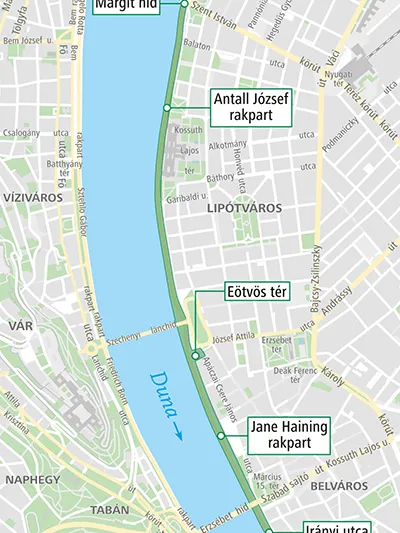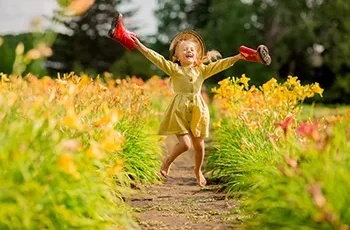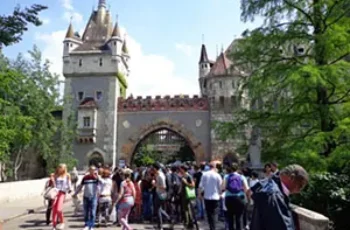National Holiday in Hungary
On March 15th Hungarians commemorate the Revolution and the following War of Independence against the Austrian-Hapsburg rule in 1848 – 1849.
This day is one of the most prominent National Holidays in Hungary with
- Commemorations, and
- Family programs in Budapest, and the rest of the country.
We recommend the family programs in the Hungarian National Museum‘s Garden, and in Buda Castle.
If you are prepared to wait out the queue you can visit the Parliament building and the Holy Crown of Hungary in it for free.
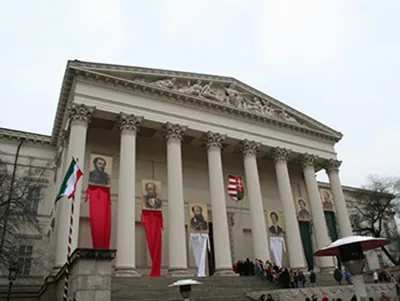
The whole city will be decked out in the national tricolor, so if you take a stroll in the centre, cross the bridges spanning the Danube, you will definitely soak up some of the commemorative atmosphere.
Table of Contents
Table of Contents – March 15 National Day
☝ Important Notes For Tourists:
- ✅ Shops, markets and services are closed on 15th March, Friday.
- ✅ Most cafés and restaurants are open though, especially in downtown Budapest.
- ✅ On 15. March Public transport services operate according to Sunday/holiday schedule, meaning less frequent services.
- ✅ On 14. March services run according to Saturday schedule. See timetables at the Budapest Public Transport Company’s (BKK) website.
🏊♀️ Bath Opening Hours Over The Holiday
Budapest Baths are open on March 15./Friday according to weekend opening hours and pricing.
Opening Hours on 15th March:
- Gellért Bath: 09.00 – 19.00
- Széchenyi Bath: 08.00 – 20.00
- Rudas Bath: 06.00 – 20.00
The thermal pools in the Rudas Spa are open for both women and men.
Tickets To the Baths (with Locker)
- Széchenyi Bath : Ticket with locker: 13 000 HUF/cc. 33.50 EUR, skip-the-line ticket: 14 000 HUF/cc. 36 EUR
- Gellért Bath (with locker): 13 000 HUF/cc. 33.50 EUR.
- Rudas Bath: Mon – Fri: 8 600 HUF/cc. 23 EUR, Sat-Sun: 12 200 HUF/cc. 32 EUR
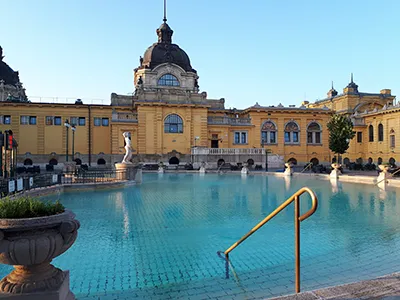
🚢 River Cruises On March 15 – 17 Weekend
Want to see the magical night view of Budapest? Danube cruises – with dinner or just drink(s) – are available on the National Holiday and they offer a great and comfortable way to enjoy all the major attractions adorning the river sides.
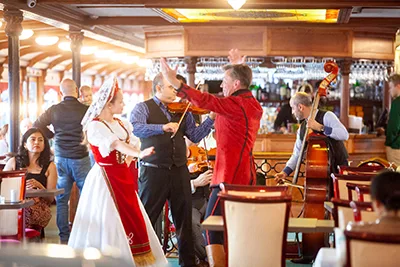
Unlimited Buffet Dinner Cruise with Folk Show
Cruise Starts: 19.00
Duration: 120 min.
Price: From €89

Drinks & Cruise with Folk Show
Cruise Starts: 19.00
Duration: 120 min.
Price: From €29

Hungarian Dinner Cruise with Folk Show
Cruise Starts: 19.00
Duration: 120 min.
Price: From €69
🤔 What Does Hungary Celebrate On March 15th?
“Rise Up Magyar the Country Calls!”
The above line is quoted from the famous Nemzeti Dal (National Song) by poet Sándor Petőfi (1823-1849) and a prominent figure of the uprising.
On 15. March in 1848 he recited the poem from the stairs of the Hungarian National Museum (Múzeum körút 14-16., M3 (blue) metro, Ferenciek tere station) for thousands of people.

Petőfi’s passionate recitation marks the beginning of the revolution against the Habsburg regime.
He was killed in one of the last battles of the war in 1849.
No Revolution day goes by without reciting the National Song during the celebrations at national monuments, especially from the stairs of the National Museum.
On 15th March Budapest, and the rest of the country are dressed up in
- Red,
- White and
- Green, the national tricolour of Hungary.
People also wear tricolor cockades pinned to their clothes.
Read below the historical background on March 15th Hungarian Revolution and the 1848-49 War of Independence.
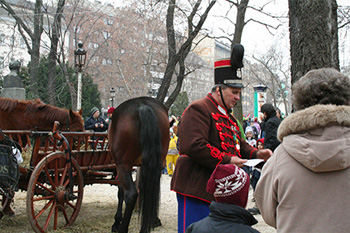
Many events accompany the official celebrations including:
- Musical and theatrical performances as well as
- Family activities in Buda Castle and in the
- Garden of the Hungarian National Museum.
Kids can go a round on horse back with the help of hussars dressed in traditional uniforms in the garden of the National Museum.
📋 Programs in Budapest: March 14 -17, 2024
You can join the commemorations at several venues.
The official government celebrations start with raising Hungary’s National Flag on Kossuth Square, in front of the Parliament at 09.00.
The Garden of the National Museum welcomes families with kids with a range of programs and activities.
Join the various family programs at various locations in Buda Castle, and the Várkert Bazaar.
All festive programs are free, do some require to register.
🎖 Government Celebrations On March 15
- 09.00 – Raising Hungary’s Flag on Kossuth Square, in front of the Parliament
- 09:30 – Procession of Hussars from the Parliament to the Hungarian National Museum: route of the procession: Alkotmány utca, Bajcsy Zsilinszky út, Károly krt., Múzeum krt.
- 10.00 – 18.00 – Festive Commemoration in the Garden of the National Museum
- Open Day in the Parliament building: 10.00 – 18.00
🏛 Hungarian National Museum – Programs On March 15 – 17, 2024,
Since the National Museum and its lovely garden were a major venue of the events of the revolution in 1848, do visit it if you wish to learn more about the historical background.
Address:
- Múzeum krt. 14 – 16., Bp. 1088, distr. VIII. (See on Map)
Opening Hours:
- Tuesday -Sunday: 10.00 – 18.00
Family programs will commeorate the national holiday on the long weekend between March 15 and 17.
We recommend that you take a walk in the beautifully renewed garden and have coffee with cake in the Geraldine/Auguszt Confectionery.
Later in the afternoon on March 15, 16 and 17- you can enjoy a beautiful light play on the facade of the museum between 17.30 and 23.00.
There will be also guided tours, lectures, presentations in Hungarian related to the revolution and war from 10.00 to 18.00 – these will be mainly be in Hungarian.
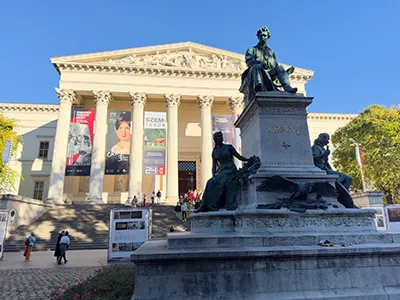
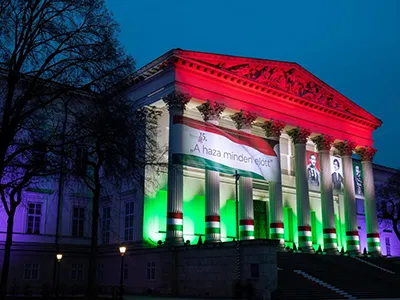
TIP: Do pop by the Geraldine Cafe (part of the historic Auguszt Confectionery family) in the garden of the museum.
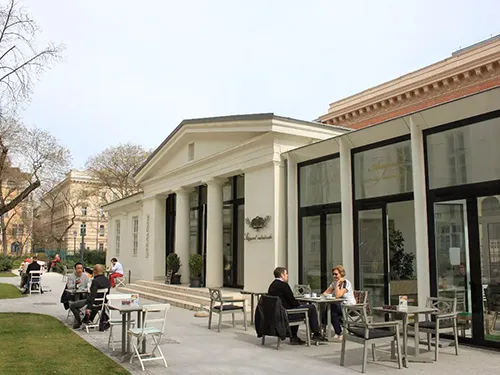

Geraldine is open Tuesday- Sunday from 10.00 to 18.00, on March 15 it will be open between 14.00 – 18.00. Have a slice of classic Auguszt cake creation, like the
- E-80 torte,
- Dobos cake or
- Krémes (square-shaped layers of puff pastry and custard cream).
They also serve savoury snacks like quiche or pogácsa (savoury scones).
Family Programs – Garden Of The National Museum,
Date & Time:
- March 15, Friday: 14.00 – 18.00
- March 16 -17, Saturday-Sunday: 10.00 – 18.00
The main activities include:
- Thematic and interactive museum routes to explore the exhibitions.
- Board games for families with kids.
- Treasure hunt.
- Colouring – little kids can join and colour a beautiful coloring booklet that lists the top artifacts of the museum.
- Baking cake in the Geraldine (Auguszt) Confectionery.
- Local delicacies in the fair – taste Hungarian specialties like langos, kürtös kalács (chimney cake) etc.
- Horse petting and riding on a pony.
- Craft workshops for the whole family.
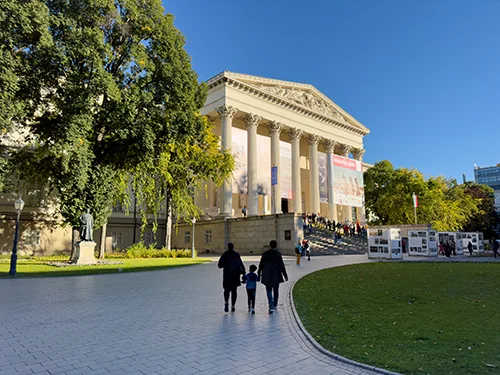

Light Show On The Facade Of The National Museum
Date & Time:
- March 15, 16, 17: between 17.30 – 23.00
The front of the museum’s building will be dressed in dazzling rays of colourful lights in memory of the revolution of 1848.
👑 Open Day In The Parliament – 15. March, 10.00 – 18.00
Open day in the Hungarian Parliament on Kossuth Square, 10.00 – 18.00 .
Take a short tour of the largest building of Budapest for free.
Visitors can access the Parliament from the direction of Alkotmány utca.
You can view the
- Impresisve Staricase Hall, the
- Cupola Hall as well as the
- Holy Crown of King St. Stephen, first King of Hungary who established the Hungarian state and introduced Christianity.

Inside The Parliament:
If you wait out the queue you’ll get to see these parts of the building, besides the Holy Crown (which is not allowed to be photograhed):
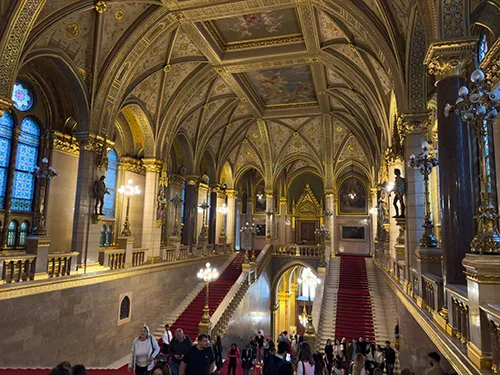
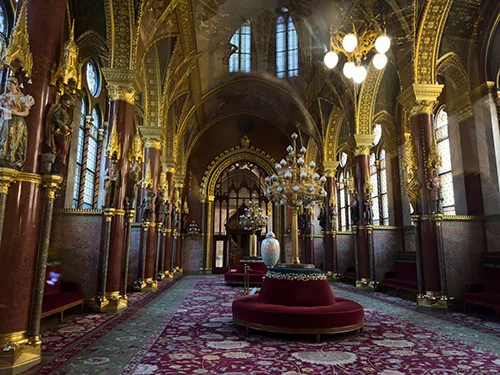
🏰 Programs In Buda Castle – March 15, 2024
Performances, exhibitions, music, dance and literature, historical walks and free family programs like:
- Weapon demonstrations and
- Mounted hussars fill the venues of the renewed Budavári Palace Quarter on the national holiday.
Most events are free, but the more popular programs require pre-registration to participate
Riding Hall (Lovarda) Programs – March 15, 10.00 – 17.00
Address:
- Royal Riding Hall in Buda Castle – Csikós udvar, BP 1014 (View on Map)
Craft Workshop, 11.00 – 18.00
- Making cockade, soldiers and hussar shako
- Beading
Weapon and Combat Demonstration, Recruitment, 14.00 – 16.00
- Weapon and combat demonstration: The historical reenactment unit will showcase the Hungarian army’s weaponry and give a drill and combat demonstration.
- Recruitment: There will be sword recruiting, children’s recruiting, basic training with wooden swords and wooden rifles, and gift paper shakos.
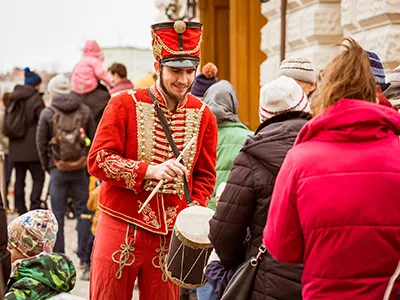
Csíkos Courtyard – Programs
Venue: see on map
Weapon Demonstration – Csikós Courtyard, 15. March, 10.00 – 17.00
Follow the clang of swords to the Csikós Couryard in Várkert Bazár!
You can learn about the various types of weapons, fighting methods and the military traditions of the past.
- Historical reenactment unit
The historical reenactment unit will showcase the Hungarian army’s weaponry and give a drill and combat demonstration.
- Recruitment
There will be sword recruiting, children’s recruiting, basic training with wooden swords and wooden rifles, and gift paper shakos.

- Artillery point
Two cannons will be on display in the Csikós Courtyard and the Riding Hall.
Mounted Hussar Patrol Demonstartion – Csikós Courtyard, 15. March
The hussars played an important role in the 1848-49 revolution and war of independence. The National Cavalry of Hungary and a special hussar unit will patrol in the courtyard.
At 13.00 and 15:00 , a full, period-correct infantry ceremonial guard patrol will march along the
- Csikós Courtyard – Main Guard – Lion’s Courtyard – Csikós Courtyard route, accompanied by drums and string musicians.
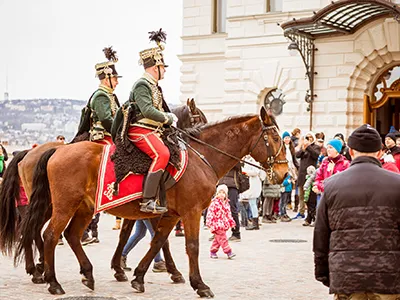
Brass Band Concert – Csikós Courtyard, 15. March, 11.30, 13.30 & 16.30
A special holiday preformance of the Hussar Band that also gives free mini outdoor concerts during the summer months.
St. Stephen’s Hall – Free To Visit on March 15
Address:
- Buda Castle Szent György tér 2, BP 1014 (See on Map)
On March 15th, you can visit St Stephen’s Hall, the renewed historical ceremonial hall of the Buda Castle Complex, free of charge.
Note: Due to the expected high interest, it is recommended to book your time slot online in advance. English language guided tours cost 6 000 HUF.
It’s a great opportunity to admire the art in the recently renovated Saint Stephen Hall and see’the accompanying exhibition, as well as the Hauszmann Story exhibition.
Details about the event:
- Date: March 15th, 2023
- Time: Free admission from 10:00 to 18.00
- Location: Lion’s Courtyard, Buda Castle
Waht Will You See?
- The renovated Saint Stephen Hall
- The accompanying exhibition on the history of the hall
- The Hauszmann Story – exhibition on the life and work of Alajos Hauszmann, the architect who designed Buda Castle
TIP: Buda Castle is the oldest part of the city rich in historical attractions.
Take your time to stroll around on its narrow, winding streets to absorb its quaint charm, then sit in a cafe or restaurant to enjoy the local cuisine.
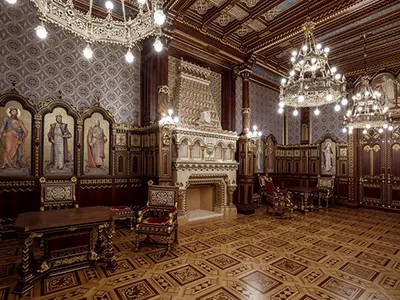
Várkert/Castle Garden: Family Programs, Concerts (Free)
Date & Time:
- March 15, Friday 10.00 – 18.00
Address:
- Ybl Miklós tér 2., district I.
The halls of the beautifully renovated Southern bazaar of the Várkert/Castle Bazaar will host various family activities and concerts for children.
Van Gogh Budapest Exhibition – Open On March 15
Budapest hosts the globally acclaimed Van Gogh – The Immersive Experience, a 360-degree multimedia art installation.
Using the latest visual techniques, the exhibition helps visitors to immerse into the unparalleled world of Van Gogh.
If you happen to be in our city and haven’t seen the exhibition then this is a great opportunity to learn why visitors worldwide, from Seoul to Los Angeles, from London to Berlin, are captivated by this super production.
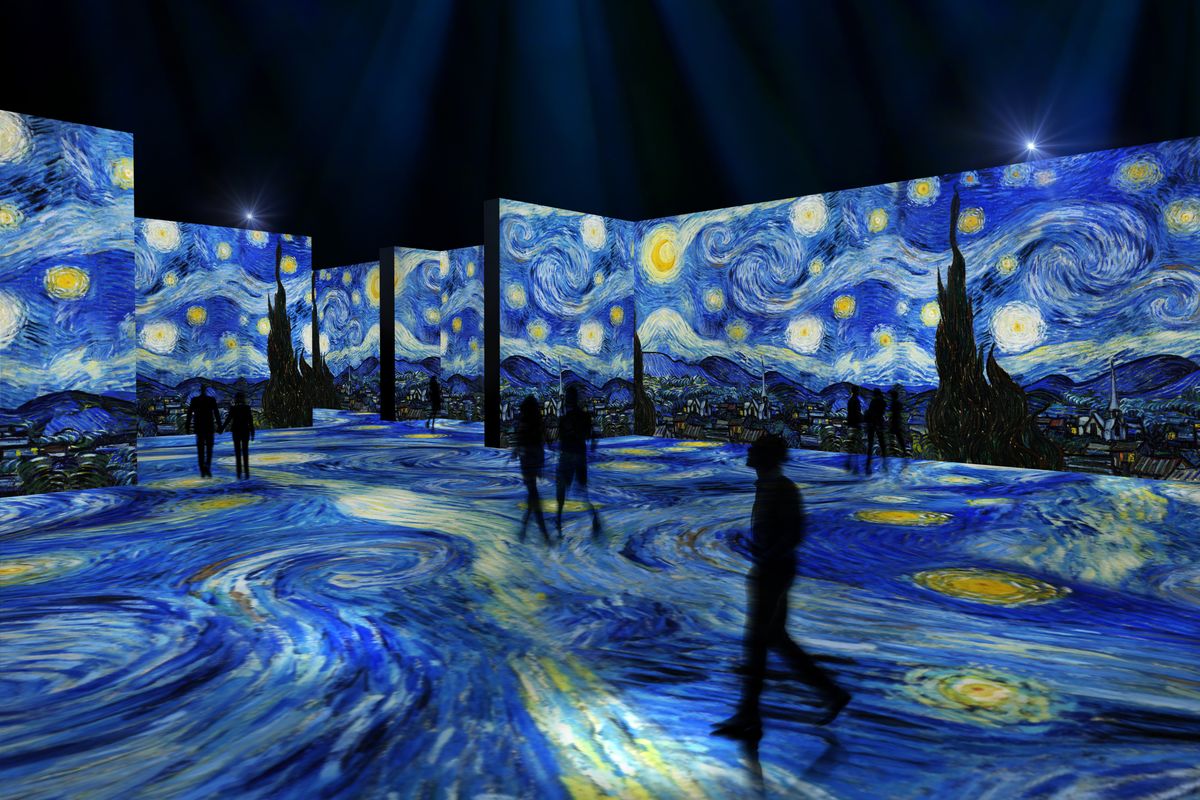
Address:
- BOK Sportcsarnok/BOK Sports & Conference Center, Budapest, Dózsa György út 1, 1146 (See on Map)
- Getting there: use M2 metro (red line) to Puskás Ferenc Stadium station, from there the xhibition venue is a 2-min walk
Opening Hours:
- Monday – Sunday: 10.00 – 19.00 (last entry at 18.00)
Tickets:
- Ticket prices differ on weekdays and weekends and whether you go between 10.00 – 14.00 or 14.00 and 19.00. Prices are in the range of 6 000 – 7 500 HUF.
More info and ticket prices on the event’s official website.
🚶♀️🚴♀️ Danube Embankment – Open to Pedestrians/Bikers, March 15 – 17
On weekends between March 15th and October 23rd, the entire width of the Pest Lower Embankment will be open to pedestrians and those arriving by bicycle or other micro-mobility devices.
The embankment opening extends from Margaret Bridge to Irányi Street.
The scenic riverbank between Erzsébet Bridge and Margit Bridge will be free to stroll
- On foot,
- Ride on bike,
- Scooter or
- Rollerblades first time in 2024 on the holiday weekend between March 15 – 17.
Come and enjoy the panorama and the proximity of the Danube river!
Walk, bike, relax and take advantage of this wonderful, huge, and free space!
Here are some additional details about the embankment opening:
- Dates: March 15th to October 23rd, 2023
- Time: Every weekend and public holiday
- Location: Pest Lower Embankment, from Margaret Bridge to Irányi Street
- Activities: Walking, relaxing, cycling, and other recreational activities
Other Venues in Budapest For Commemorating March 15th
Besides the Parliament and Buda Castle, other places where official celebrations take place include
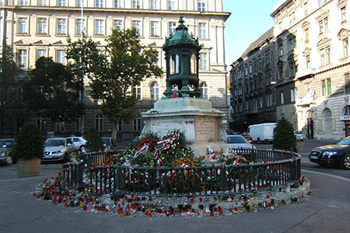
- Petőfi Statue (Petőfi tér, near Elizabeth bridge, tram 2) and
- The Batthyány Eternal Flame (Batthyány Örökmécses, Báthori utca, district V., M2 metro Kossuth tér station).
Count Lajos Batthyány was the prime minister of the first responsible Hungarian government in 1848-49.
He was executed by a firing squad at the site of the memorial during the Habsburg’s retaliation following their victory over the Hungarian army.
The eternal flame has been burning in memory of him since 1926.
Brief Historical Background On 15th March
The Hapsburg and their allies liberated Buda from the 150-year Turkish occupation in 1686. However Hungary did not become a free country but a province of the Austro-Habsburg Empire.
Hungarians fought against the Habsburg oppression throughout the coming centuries.
The most important anti-Habsburg movements include
- the Thököly movement, and
- the War of Independence in 1703 – 11 lead by Ferenc Rákóczi.
The Austrians had beat down these movements.
The first half of the 18th century was a period of compromise between the Austrian rulers and Hungary.
Influenced by the events of the French revolution, a new resistance movement, the Jacobin, emerged in Hungary toward the end of the 18th century.
Lead by Ignác Martinovics, the Jacobins’ main objectives were
- the independence of Hungary and
- transforming the country to a bourgeois society.
The Jacobin movement failed too. The Habsburgs arrested and executed the leaders of the organization.
The Reform Era
The Hungarian Reform Era started in 1825 when at the diet Count István Széchenyi (1791-1860) offered his 1-year income to establish the Hungarian Academy of Sciences.
Széchenyi become a prominent figure of this era facilitating great developments in Budapest and the country. The other outstanding personality of this era was Lajos Kossuth.
The spirit of nationalism arose in other European countries and capitals and they only heightened the enthusiasm of Hungarian reformers.
On political level Lajos Kossuth’s fiery speeches provoked anti-Habsburg feelings while Sándor Petőfi roused common people through his uplifting poems.
Who Was Sándor Petőfi (1823 Kiskőrös – Presumed Death: 1849)?
He’s Hungary’s most celebrated romantic poet and a fervent fighter for the nation’s independence.
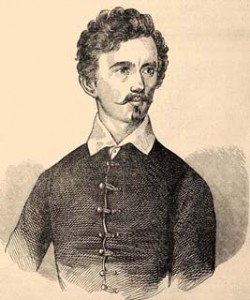
Petőfi roused the Hungarian people against the Austrian-Habsburg oppression reciting the verses of his National Song/Nemzeti Dal from the steps of the National Museum on the morning of March 15. in 1848 (though according to current knowledge this is just an urban legend).
He also participated in drawing up the famous 12 points (also recited from the steps of the museum ) – a summary of the Hungarian revolutionaries’ demands.
He wrote nearly 1000 poems during his short life (around 875 survived and are known today).
Petőfi’s Most famous Works
Every Hungarian knows his best-known romantic poems by heart. Some of them like the At the End of September were translated into most languages of the world.
His epic poem János Vitéz/John the Valiant is also very popular. It’s been made into a musical, puppet show, cartoon, and rock opera.
Petőfi also wrote a lot about his homeland the Great Plain/Alföld (Az Alföld, A Tisza, A puszta, télen) raising the bleak “puszta” to poetic heights.
In the War of Independence of 1849 he fought in the Hungarian army as captain. He thought to had been killed (or captured) in the last and lost battle of the war, at Segesvár on 31. July in 1849.
Today many street names, statues, memorials, museums keep his memory in Hungary and the neighbouring countries of the Carpathian basin.
TIP: The Petőfi Literary Museum in the Károlyi Palace (Károlyi utca 16., district V., downtown Budapest) has one of the largest collections on the works of Petőfi as well as a permanent exhibition on his life complete with audio-visual tools and apps titled: Who Am I? I Will Not Say…” Petőfi’s Choices Admission: 800/400 HUF.
The Revolution On 15th March 1848

The revolutionary wave that had swept over Europe in spring 1848 resulted in a bloodless revolution in Hungary on 15th March.
A bunch of Hungarian poets and writers formed the core of the radicals.
They were preparing for a demonstration on 19th March at their regular meeting place, the Café Pilvax.
They heard the news of the revolution in Vienna on the evening of 14th March so they decided to bring forward the demonstration.
The revolutionaries started to gather people while reciting
- Petőfi’s National Song and
- reading their demands worded in the 12 points (kids at school have to learn it by heart when they learn about the Revolution).
The Most Important Demands Were:
- Freedom of press, abolition of censure
- Freedom of religion
- A national bank
- Independent jury
- Abolition of feudal conditions.
The 1st Independent Hungarian Government
The mass lead by Petőfi in the pouring rain occupied a press and printed out the poem and the 12-points.
The Hapsburgs didn’t dare to intervene. Despite the rain, an even bigger crowd gathered in the garden of the National Museum by afternoon.
Following the events on 15th March, a Hungarian delegation went to Vienna to tell their demands to Ferdinand V. After several discussions the Habsburgs accepted an independent Hungarian ministry lead by Count Lajos Batthyány.
“We swear unto thee – that slaves we shall no longer be!”
In summer 1848 Vienna decided to take action against the Hungarian revolution.
The ethnic minorities living in Hungary weren’t happy with the Hungarians’ victory. The Croats allied with Austria and their troops attacked and invaded Hungary.
Although the Habsburgs had more power and larger army, they weren’t strong enough to defeat Hungarians. Austria convinced Russia to provide support for breaking down the Hungarian War of Independence.
Despite being a small country, Hungary humiliated Austria by fighting tooth and nail and by surrendering not to the Emperor but to the Russian Czar in August 1849.
Age Of Terror
Following the defeat, retribution began.
Fourteen generals were executed at Arad on 6th October 1849. Count Batthyány Lajos, Hungary’s first prime-minister was shot at Pest, and thousands were sentenced to death or prison.
The Habsburgs built the Citadel fortress on Gellért Hill at that time with cannons directed at the town below.
The age of terror stifled Hungary in the coming years.
Related:
More Events, Things To Do in March – Easter Programs and Traditions – April Events – May Day Programs – St. Stephen’s Day August 20. – October 23. 1956 Revolution
